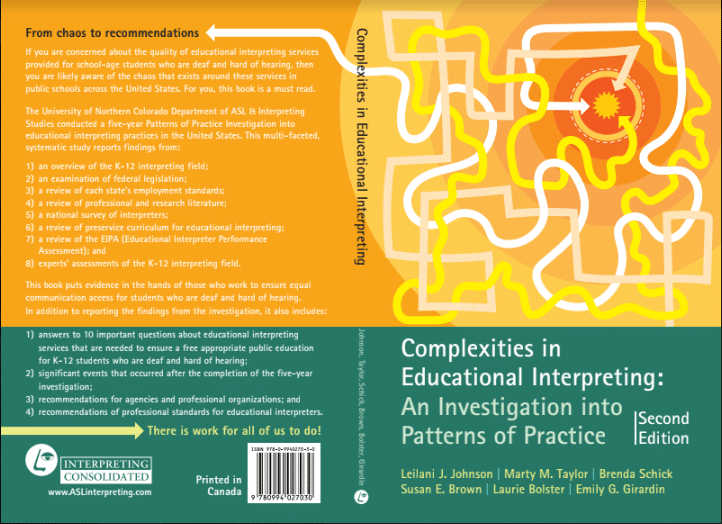by Dr. Kim B. Kurz
An excerpt from: Complexities of Educational Interpreting: An Investigation into Patterns of Practice – Second Edition, by Johnson, Taylor, Brown, Bolster, Girardin, pp. 19-21.
Ideally, all children should have full access to language at an early age and not be deprived of language, especially at a young age (Kurz & Metzger, 2021). However, for deaf children this is often not the case. Because many deaf children are born into hearing, nonsigning families, they are ushered into the education system with limited language (Freel et al., 2011; Kushalnagar et al., 2010; Schick et al., 2013; Stevenson & Baker, 1987). Research has just begun to open doors to the exploration of the impact of Deaf Interpreters (DIs) in the K-12 settings (Wanis, 2018). So much more remains to be discovered, examined, and shared. Typically, a DI is deaf, a fluent signer, demonstrates expertise in culture and linguistics, and serves as a professional communication mediator to ensure that Deaf consumers receive effective communication and convey their thoughts accurately (Adam et al., 2014; Boudreault, 2005; Stone, 2009; Stone & Russell, 2014). Deaf interpreters are seen as ‘balanced bilinguals’ who assist with clarifying communication among peers and with hearing people (Boudreault, 2005; Kannepell, 1993).
What makes DIs different from hearing interpreters is that they belong to a community with a shared language and culture, they understand and have experiences in the Deaf world (Forestal, 2014), and they have access to the majority culture as well. These unique characteristics of DIs contribute to the extra-linguistic knowledge that most non-deaf interpreters do not have (Adam et al., 2014). When interpreting from a deaf child, DIs are more likely to capture nuances of meaning and intention in the deaf child’s expressed language (Boudreault, 2005). Likewise, they often can convey meaning and intention from professionals in education more effectively to young deaf and hard of hearing students and those who have especially weak sign language skills. DIs are also able to share their common linguistic and cultural experiences as a Deaf person, information and modeling that hearing interpreters generally cannot provide. For many people, these are reasons they feel that educational settings should include DIs, especially since school years are a critical period for Deaf and Hard of Hearing (DHH) children to develop language, cognitive, and social skills.
A large majority of sign language interpreters who graduate from interpreting programs are second language learners and learned ASL for the first time in a college classroom (Cogen & Cokely, 2015; Winston & Cokely, 2009). Caselli et al. (2020) argued that “using interpreters instead of appropriate educational supports may exacerbate symptoms of language deprivation by prolonging the period of time a child goes with limited access to language” (p. 1,323).
Winston (2004b) describes how some language myths of an interpreted education includes the false assumption that interpretation and transliteration are language models for DHH students’ language acquisition and/or development. To become language models, educational interpreters need to have strong academic content knowledge and the ability to unpack academic information between two languages from the lexical level to the discourse level in order to interpret effectively (Kurz et al., 2018).
There is a common misconception that interpreting in a school is ‘easier’ or low-risk and that the educational setting is one of the best places for novices or recent interpreter graduates to begin developing their ASL and interpreting skills (Johnson et al., 2018). It has been blatantly and wrongly assumed that the most advanced hearing interpreters and DIs should be working in the community and that the least qualified interpreters, whose second language is ASL, or who may have recently graduated from an interpreting program, should begin their careers interpreting in educational settings (Bowen-Bailey, 1996). Some people even believe such interpreters should begin working in lower grades since those children have simpler vocabulary and language.
I challenge readers to begin thinking about providing a rich language and cultural experience for the mainstreamed deaf child by bringing in DIs who can serve as language models and cultural mediators as well as role models for deaf children, especially at younger ages. It is a common misconception that the DIs will automatically replace hearing interpreters. DIs and hearing interpreters work together to provide enhanced accessibility for deaf children. The mainstream experiment needs to include DIs and look at how to stop or minimize the language deprivation of deaf children so that they can thrive in their social identity, language, and culture.
Purchase a copy here: https://www.aslinterpreting.com/complexities-in-educational-interpreting/



